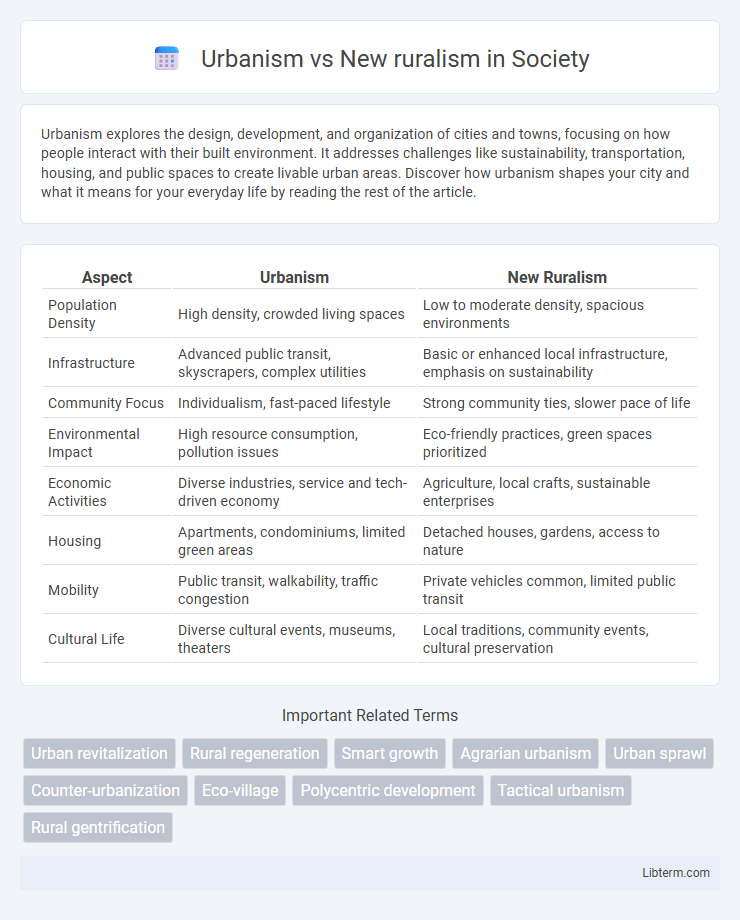Urbanism explores the design, development, and organization of cities and towns, focusing on how people interact with their built environment. It addresses challenges like sustainability, transportation, housing, and public spaces to create livable urban areas. Discover how urbanism shapes your city and what it means for your everyday life by reading the rest of the article.
Table of Comparison
| Aspect | Urbanism | New Ruralism |
|---|---|---|
| Population Density | High density, crowded living spaces | Low to moderate density, spacious environments |
| Infrastructure | Advanced public transit, skyscrapers, complex utilities | Basic or enhanced local infrastructure, emphasis on sustainability |
| Community Focus | Individualism, fast-paced lifestyle | Strong community ties, slower pace of life |
| Environmental Impact | High resource consumption, pollution issues | Eco-friendly practices, green spaces prioritized |
| Economic Activities | Diverse industries, service and tech-driven economy | Agriculture, local crafts, sustainable enterprises |
| Housing | Apartments, condominiums, limited green areas | Detached houses, gardens, access to nature |
| Mobility | Public transit, walkability, traffic congestion | Private vehicles common, limited public transit |
| Cultural Life | Diverse cultural events, museums, theaters | Local traditions, community events, cultural preservation |
Understanding Urbanism: Definitions and Key Concepts
Urbanism encompasses the study and design of cities, focusing on the interaction between built environments and social, economic, and cultural dynamics. Key concepts include density, mixed-use development, walkability, public transit, and the role of public spaces in fostering community engagement. This framework contrasts with New Ruralism, which emphasizes sustainable living, local agriculture, and preserving rural landscapes while promoting small-scale, community-oriented development.
What is New Ruralism? Origins and Principles
New Ruralism emerges as a design and planning philosophy advocating for sustainable, community-oriented rural development, blending ecological stewardship with modern living. Rooted in reactions against sprawling urbanization and industrial agriculture, its origins trace to late 20th-century movements emphasizing local agriculture, environmental conservation, and cultural heritage preservation. Key principles include promoting mixed-use developments, enhancing local economies through small-scale farming, and fostering social cohesion by creating walkable, interconnected rural communities.
Urban Density vs Rural Spread: Comparing Land Use
Urban density emphasizes maximizing land use efficiency through vertical development, creating compact neighborhoods that support walkability and reduce reliance on automobiles. In contrast, new ruralism advocates for dispersed, low-density settlements that preserve natural landscapes and promote agricultural activities while maintaining community cohesion. Comparing land use, urban density minimizes environmental impact per capita by limiting urban sprawl, whereas rural spread often results in higher land consumption and infrastructure costs per resident.
Sustainability: City Life or Rural Revival?
Urbanism emphasizes high-density living, efficient public transportation, and green building technologies to reduce carbon footprints and promote sustainable city ecosystems. New Ruralism advocates for revitalizing rural areas through local agriculture, renewable energy use, and community-based resource management to foster sustainable livelihoods and environmental stewardship. Both models aim to balance human needs with ecological health, presenting divergent yet complementary paths to sustainability.
Community and Social Life: Contrasts and Similarities
Urbanism fosters dense, diverse communities with numerous social interaction opportunities through mixed-use spaces and public transportation systems. New ruralism emphasizes smaller, close-knit communities with strong interpersonal connections and shared local resources, promoting a slower, nature-integrated lifestyle. Both approaches value community resilience and social cohesion but differ in scale and the intensity of social networks.
Economic Opportunities: Urban Hubs vs Rural Innovation
Urban hubs concentrate economic opportunities through dense networks of industries, tech startups, and corporate headquarters, fostering rapid job creation and innovation. New ruralism drives economic growth by promoting sustainable agriculture, eco-tourism, and remote work initiatives, enhancing local entrepreneurship and resource-based industries. Balancing urban economic dynamism with rural innovation creates diversified opportunities critical for regional development and resilience.
Transportation and Infrastructure Challenges
Urbanism emphasizes dense transportation networks including extensive public transit systems, bike lanes, and pedestrian infrastructure to support high population density, whereas New ruralism focuses on integrating sustainable infrastructure that maintains rural character while improving connectivity. Rural areas often face challenges such as limited public transportation options and underdeveloped road networks, creating obstacles for sustainable mobility and economic growth. Balancing efficient transportation infrastructure with environmental preservation remains a critical challenge in both urban and rural planning paradigms.
Housing Trends: Urban Condos vs Rural Homesteads
Urban condos emphasize high-density living with modern amenities, catering to professionals seeking convenience and proximity to city centers. In contrast, rural homesteads highlight spacious land ownership, self-sufficiency, and a connection to nature, appealing to those prioritizing privacy and sustainable lifestyles. Housing trends reflect a growing divergence between compact urban development and expansive rural settlement models.
Environmental Impact: Carbon Footprints in Urban and Rural Areas
Urbanism typically results in higher population density and greater energy consumption, contributing to elevated carbon footprints due to transportation emissions and concentrated industrial activity. New ruralism emphasizes sustainable practices, low-impact agriculture, and decentralized living, often leading to reduced carbon emissions per capita by promoting local resources and renewable energy use. Both approaches influence environmental impact differently, with urban areas facing challenges in reducing emissions while rural models focus on harnessing natural landscapes to minimize carbon footprints.
The Future of Living: Blending Urbanism and New Ruralism
The future of living emphasizes blending urbanism's dense, walkable environments with new ruralism's emphasis on sustainability, community, and green spaces, creating hybrid models that balance technological innovation with ecological stewardship. Integrating smart city infrastructure and local agriculture fosters resilient communities that support diverse lifestyles and reduce environmental impact. This synthesis promotes healthy, connected living spaces that prioritize social interaction, affordable housing, and access to nature.
Urbanism Infographic

 libterm.com
libterm.com